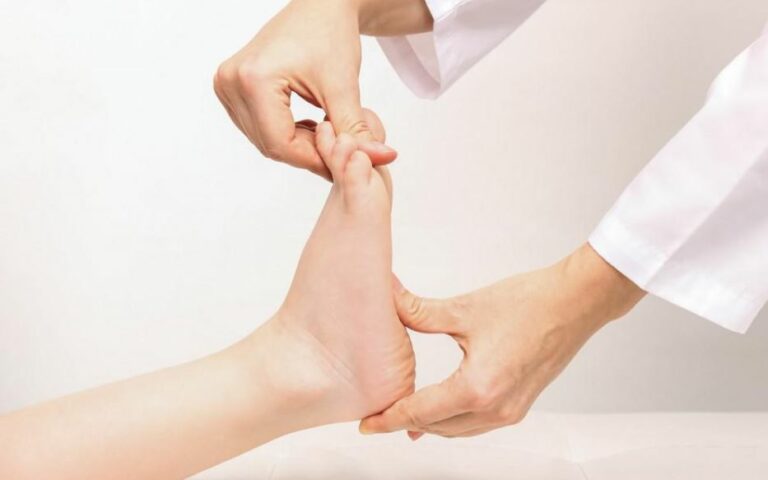The eyes may be the windows to your soul, but are your feet are the windows to your overall health?
Unless you regularly get foot massages and pedicures, you probably don’t give your feet much attention or even a second glance. But, if you take a closer look, your feet and toes could reveal signs of an underlying medical condition. Most people don’t usually don’t get concerned about their feet until they’ve bruised, sprained or have broken something, your feet can tell you a great deal about your overall health.
8 Potential Warning Signs Your Feet May Be Telling You
1. Cold feet and toes
Possible medical issue: vascular disorders due to familial tendencies, diabetes, smoking and other factors, peripheral artery disorder (PAD) or circulation problems due to diabetes
While you may just need to bundle up and sit by the fire for a bit, having cold feet may point to a vascular disorder or circulatory problem. Restricted blood flow from PAD can cause your feet or toes to feel colder than the rest of your body. Conditions associated with PAD may be occlusive (when an artery becomes blocked) or spastic (when an artery constricts due to a spasm). An example of occlusive is peripheral arterial occlusion, and an example of spastic is Reynaud’s disease.
2. Burning pain
Possible medical issues: neuropathy, PAD, peripheral neuropathy due to diabetes or other factors
Although most burning pain in feet is due to nerve damage in the legs, called neuropathy, inflammation of the feet, such as athlete’s foot, and those with PAD can cause burning pain in the feet as well.
3. Sudden swollen and painful big toe or foot
Possible medical issues: gout, cellulitis infection, neuropathic arthropathy (Charcot joint), possible deep vein thrombosis, or systemic arthritis, such as rheumatoid or psoriatic arthritis
While you may experience swelling of the foot and ankle, from improper footwear or pregnancy. Swollen feet and ankles could also be a sign of something more serious such as neuropathic arthropathy, arthritis, venous insufficiency, renal disease, congestive heart failure or gout. On the surface, gout, a type of inflammatory arthritis caused by elevated levels of uric acid, may seem very straightforward—other times it may not. It can mimic many things like infection, fractures, inflammatory arthritis, Charcot arthropathy or neuropathic arthropathy, and venous insufficiency or deep vein thrombosis.
4. Discolored or deformed toenails
Possible issue: nail fungus, injury, psoriasis, anemia, melanoma
When your toes are discolored or deformed there could be many culprits. Some of the common things are nail fungus and overuse injuries from repetitive trauma, starting and stopping, kicking and other athletic endeavors. If you notice your toenails have changed in color, have little holes (pits), white lines, look sunken or spoon-shaped, these could indicate other underlying medical conditions listed above.
5. A sore or ulcer that won’t heal
Possible issue: diabetic foot ulcer or ankle ulcer due to venous insufficiency, peripheral neuropathy, basal cell or squamous cell carcinoma, malignant melanoma, PAD
Typically, sores should heal within a reasonable amount of time. If you notice an ulcer or sore isn’t healing, it could be due to poor circulation caused by diabetes or peripheral neuropathy. Although most people associate skin cancer with other parts of the body, your sore or ulcer could also indicate an evolving skin cancer.
6. Dark line or bruise under your toenail
Possible issue: melanoma, subungual hematoma
Although rare, the discolored spot underneath your toenail could be a sign of melanoma, a potentially fatal form of skin cancer. It usually appears like a brown or black streak or looks similar to a bruise. It also could be due to an injury or trauma to the nail, which can cause a subungual hematoma (bleeding under the nail).
7. Weight-bearing pain in the foot with no trauma
Possible issue: stress fracture, plantar fasciitis, tendinitis, arthritis, diabetic arthropathy
Foot and ankle pain bring millions of Americans to podiatrists’ offices each year. Some of the common injuries are due to stress fractures, tendonitis, and plantar fasciitis. Pain and injury can also be related to arthritis and diabetic arthropathy.
8. Numbness or tingling in feet and toes
Possible issue: peripheral neuropathy, b12 deficiency, spinal stenosis, and other neurological conditions, diabetes, chemotherapy
Everyone’s limbs fall asleep now and then, but if you notice that your feet and toes are regularly tingling for longer than a few minutes, check in with your podiatrist as it could be a sign of something more serious.
It’s good to keep an eye on your feet. Be kind to those hard-working body parts. They just might have something important to tell you.
The post What are your feet trying to tell you? appeared first on Bethesda Foot & Ankle Center.









